#pollinator gardening
Explore tagged Tumblr posts
Text
Some of you may have heard about Monarch butterflies being added to the Threatened species list in the US and be planning to immediately rush out in spring and buy all the milkweed you can manage to do your part and help the species.
And that's fantastic!! Starting a pollinator garden and/or encouraging people and businesses around you to do the same is an excellent way to help not just Monarchs but many other threatened and at-risk pollinator species!
However.
Please please PLEASE do not obtain Tropical Milkweed for this purpose!
Tropical milkweed (Asclepias curassavica)--also commonly known as bloodflower, Mexican butterflyweed, and scarlet milkweed--will likely be the first species of milkweed you find for sale at most nurseries. It'll be fairly cheap, too, and it grows and propagates so easily you'll just want to grab it! But do not do that!
Tropical milkweed can cause a host of issues that can ultimately harm the butterflies you're trying to help, such as--
Harboring a protozoan parasite called OE (which has been linked to lower migration success, reductions in body mass, lifespan, mating success, and flight ability) for long periods of time
Remaining alive for longer periods, encouraging breeding during migration time/overwintering time as well as keeping monarchs in an area until a hard freeze wherein which they die
Actually becoming toxic to monarch caterpillars when exposed to warmer temperatures associated with climate change
However--do not be discouraged!! There are over 100 species of milkweed native to the United States, and plenty of resources on which are native to your state specifically! From there, you can find the nurseries dedicated to selling native milkweeds, or buy/trade for/collect seeds to grow them yourself!!
The world of native milkweeds is vast and enchanting, and I'm sure you'll soon find a favorite species native to your area that suits your growing space! There's tons of amazing options--whether you choose the beautiful pink vanilla-smelling swamp milkweed, the sophisticated redring milkweed, the elusive purple milkweed, the alluring green antelopehorn milkweed, or the charming heartleaf milkweed, or even something I didn't list!
And there's tons of resources and lots of people willing to help you on your native milkweed journey! Like me! Feel free to shoot me an ask if you have any questions!
Just. PLEASE. Leave the tropical milkweed alone. Stay away.
TLDR: Start a pollinator garden to help the monarchs! Just don't plant tropical milkweed. There's hundreds of other milkweeds to grow instead!
#milkweed#monarchs#monarch butterfly#pollinator garden#pollinator gardening#outdoor gardening#gardening#flower gardening#out of queue#ani rambles
20K notes
·
View notes
Text
Milkweed Lovers Everywhere, Heed My Warning
By all means let me know if I'm wrong here, but if I'm not wrong then we're looking at a serious (at least to me) problem.
I've been trying to stray away from Tropical Milkweed (Asclepias curassavica) and towards more native species in my area--things like swamp, sandhill, etc--and Butterflyweed (Asclepias tuberosa) fits in that category for me. It's hard to find native milkweed plants in stores--even places I've gone to in the past that had a handful of native species are currently only selling Tropical Milkweed. Even still, I know that there's been a good bit of buzz around growing native species, and some stores I've visited have said they're trying to find vendors with native species--they're not only selling Tropical for lack of trying.
So imagine my surprise--and delight--when I go to Lowe's and see Asclepias tubersoa blazoned on a plant label!
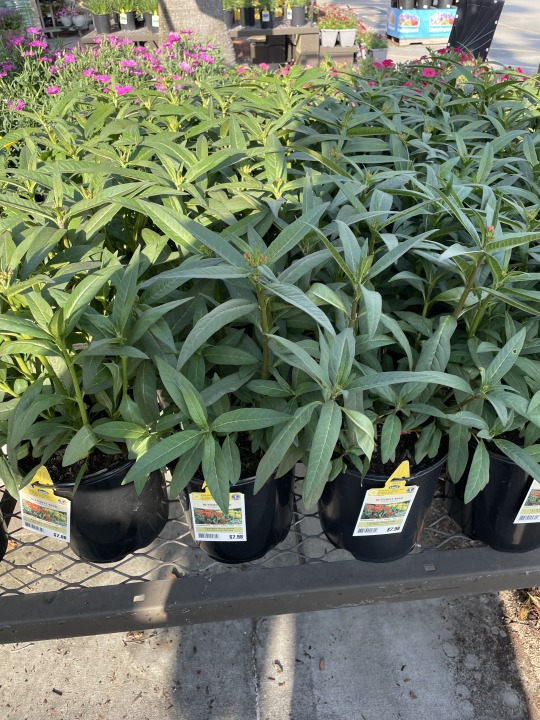
And imagine my surprise when it's being sold right next to Tropical Milkweed and looks almost identical to it.
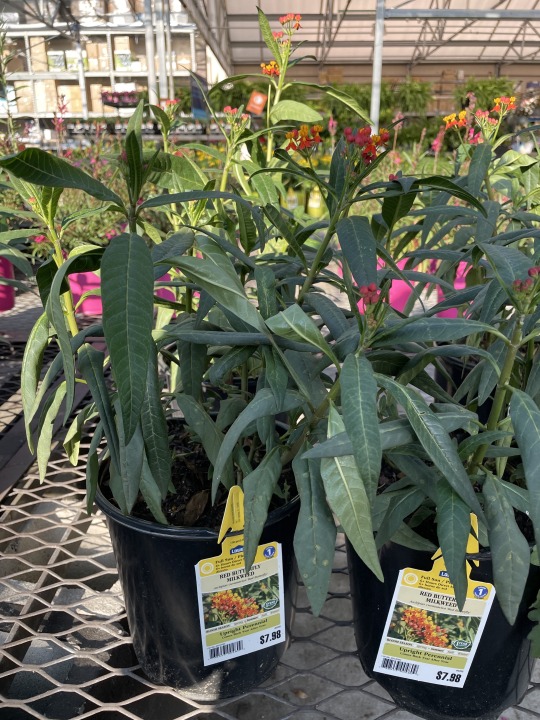
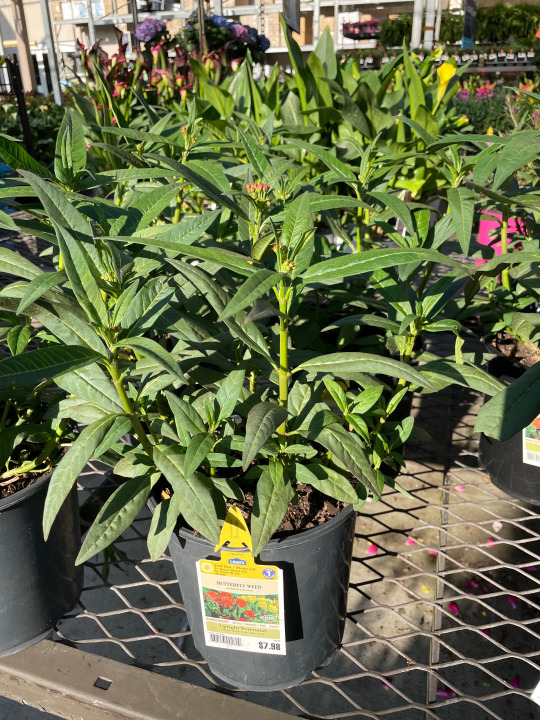
I was immediately suspicious--especially considering the red flower buds on the 'Butterfly weed'. I've grown Tropical Milkweed for several years, and while it's been awhile since I've seen a Butterfly Weed plant outside of a photograph, these definitely didn't look like what I'd seen. Not to mention, I'd only heard of Asclepias tuberosa flowering in orange or yellow--not red. Of course, at the same time, I'm not a professional botanist, and a quick google search did declare that butterfly weed can grow in red (though the images all look like asclepias curassavica to me...).
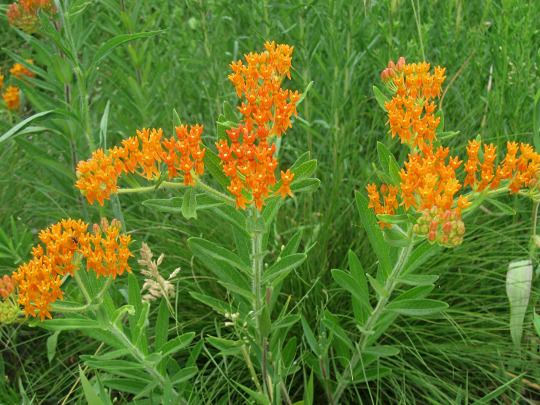
(Image from the Native Plant Database. Looking at this picture, I should've realized where this was going sooner...)
So I did the reasonable thing and bought two of them. I figured if the red buds somehow turned orange and were actually Butterfly Weed, then I'd be perfectly satisfied. If they turned out to be Tropical Milkweed, well, I simply would give them to my neighbor who's fond of them, or find something else to do with them.
(I feel the need to emphasize; there are a lot of people online who are in the 'if you plant tropical milkweed you're a horrible person and intentionally killing monarch butterflies' camp. I am not one of them; it's not invasive in my area of Florida, it just takes a little bit of extra managing in terms of cutting it back in October/November.)

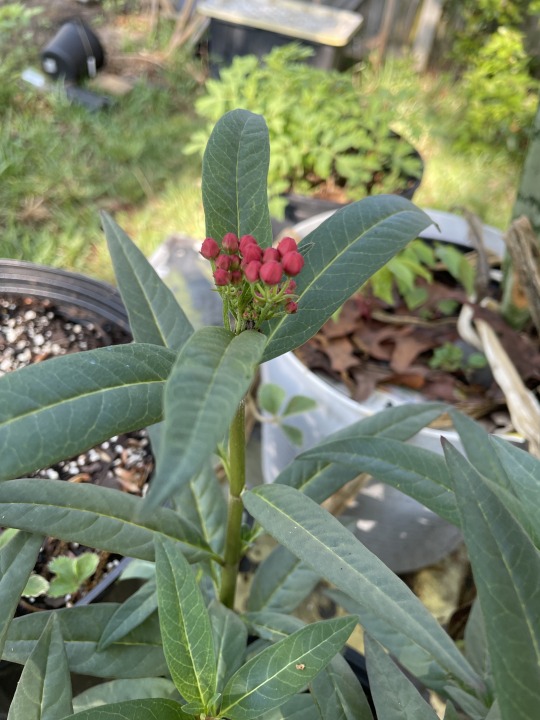
I ended up in the same Lowe's again today, shopping for my mom, and took a peek at their plant selection. Lo and behold, I found the Butterfly Weed, and...
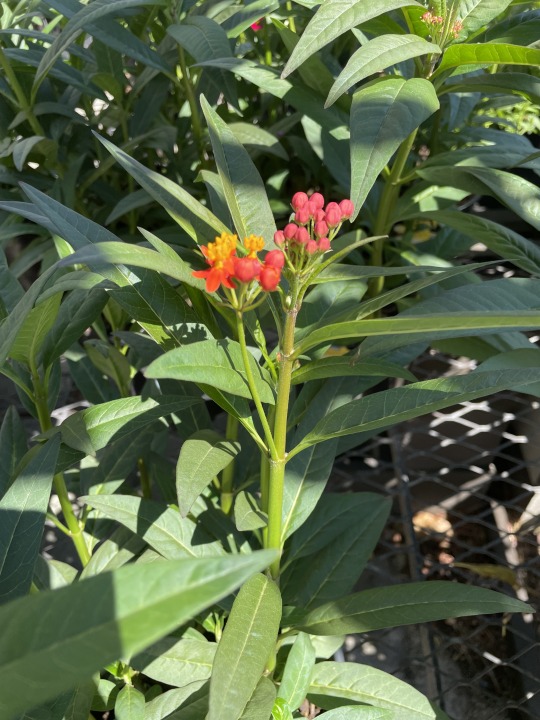
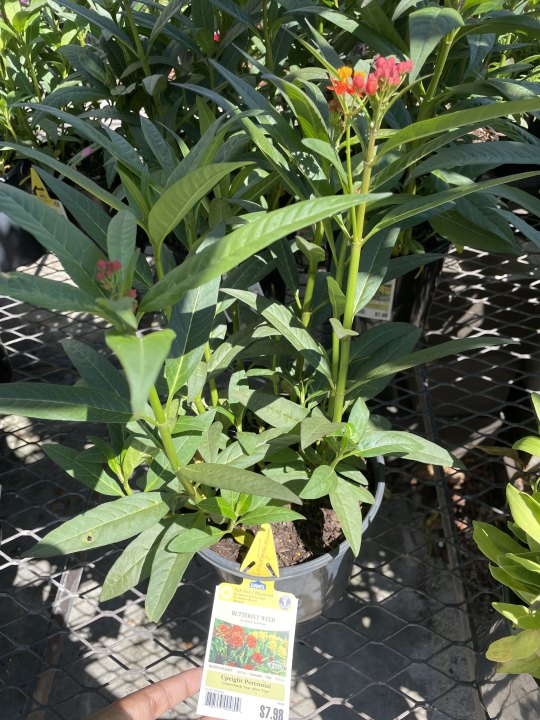
This sure does look like Tropical Milkweed to me, and to others in my gardening server, yet it's still labeled as 'Butterfly Weed.' Also, I didn't see any Tropical Milkweed on any of the shelves--at least, nothing labeled as Tropical Milkweed. Instead, all I saw was Tropical Milkweed disguised as Butterfly Weed.
This is, in my humble pollinator garden enthusiast opinion, a problem. At best, Lowe's--or the company they source their plants from--is mislabeling their plants on accident. Which could cause problems if people are buying the plants and putting them in a place that's not quite the right condition for them, or create severe disappointment if someone's excited to grow the native Asclepias tuberosa only to end up with something else entirely. At worst? Lowe's--or the company they source their plants from--are aware that people want to grow native milkweed and are either unable to or too lazy to grow them, and would rather try to get away with selling Tropical Milkweed--which has been growing increasingly controversial in some gardening circles--and still reap the benefits and profits of selling native milkweed species.
However, I'll be real? I'm not sure what exactly to do about it. So I guess I'm just letting everyone know; if you see 'Butterfly Weed (Asclepias tuberosa)' in your local Lowe's, at least double check. Otherwise, you may plant Tropical Milkweed/Scarlet Milkweed (Asclepias curassavica) instead.
#milkweed#gardening#flowers#pollinator gardening#pollinator garden#Lowe's#tropical milkweed#butterfly weed#asclepias curassavica#asclepias tuberosa#outdoor gardening#flower gardening#ani rambles#out of queue#idk how legible this post is but I hope its at least SOMEWHAT legible yknow?
938 notes
·
View notes
Text
Native plant enthusiasts in Ontario, Canada, this is for you.
Leaving Facebook, I miss the Ontario Native Plant Gardening group. I couldn't find any communities on alternative social media so I'm working on making my own. Although Facebook will always be the mecca for the older generation of gardeners, I think it's worth forging some communities elsewhere, even if they're smaller, for those of us who deleted Meta apps. There's benefits to small communities, too, like less off-topic spam and less bad advice.
The Goal:
To create a space to share pictures, information, resources, news, and ask questions, get advice, help newbies get started, and trade seeds and plants, specific to PLANTS NATIVE TO ONTARIO, CANADA.
Gardening of highly cultivated or exotic plants (e.g., most garden veggies and herbs) is off-topic; while it may be discussed incidentally, posts/activity that is totally focused on it will be removed. Discussion of removing invasive plants is also allowed, while promoting the planting of invasive plants is not allowed.
Links:
Discord: DM me (@vormoranox) for link because I don't want to invite bot spam by posting it widely here.
BlueSky "custom feed" (like it and pin it): https://bsky.app/profile/did:plc:c4bxovkrkuszkrw6m25tyiix/feed/aaac75apohl
Reddit (VERY barebones as of Feb 2025, setting up a subreddit is kind of crazy and I've only basically picked the name and effectively nothing else and I'm very new to this): /r/OntarioNativePlants








#Canada#Ontario#Ontario Native Plants#Native plants#Native plant gardening#Ontario native plant gardening#Gardening#Pollinator gardening#Pollinators#Native species#Ontario Canada#buy Canadian#Plant and seed exchange#Ecology#Supporting pollinators#Habitat gardening#Eco friendly gardening#Pollinator habitat#Ontario species#Canadian species#Ontario plants#Ontario gardeners#Gardeners#Canadian gardeners
3 notes
·
View notes
Text
Butterfly & Pollinator Garden
Hey everyone I have decided to turn a section of my front garden into a butterfly garden. Well as I am doing the research I found a super useful resource on which milkweed and other plants for your region to plant for Monarch butterflies. Like super in depth charts of what plants depending on your region. Which yes, it is mostly for the US and I live in Canada but it is close enough to be useful for me. So since it is still just May I want to send this out to anyone else that has wanted to plant flowers for butterflies or monarchs in specific.
5 notes
·
View notes
Text

Helping out your local ecosystem is super gay.
#plants#botany#gardening#environment#garden#queer community#lgbt artist#nonbinary artist#native plants#pollinator gardening#pollinators#environmentalism#ecology#ecosystem#endangered species#conservation#wildlife conservation
2 notes
·
View notes
Text


margarida.sa.maia
#meadows#wildflowers#gardens#pollinators#nature#ecologicalgardening#biodiversity#wildlife friendly gardening#rewilding#ornamental grasses#curators on tumblr
2K notes
·
View notes
Text
LINK FEST: 20 JUNE 2023
Links that may or may not be related to gardens, food, travel, nature, or heterotopias and liminal spaces but probably are. Sources in parentheses. guide: Gardening for Pollinators (Native Plant Trust). A 34-page PDF with many helpful suggestions for successful pollinator planting. photos: La France: Pictures from two weeks’ touring (Rosecrans Baldwin/Meditations in an Emergency). Nice sense of…

View On WordPress
#apocalypse#climate#end of world#France#humour#linkfest#links#marketing#native plants#pollinator gardening#pollinator plants#pollinators#real estate photos#talking to children#travel photos#wildfire smoke
0 notes
Text
World got you down?

Feeling overwhelmed?

Let’s plant some goddamn native wildflowers.

#I can and will feed pollinators and have a nice time in the process#This is my vow#garden time#(not all of these are natives I did save some sweet peas for scent because I’m a sucker)#but there’s a great mix from the local high school’s native nursery that I’ll be adding#and a couple milkweed starts#don’t let the bastards get you down
290 notes
·
View notes
Text
"Next Monday [6/17/24] is the start of National Pollinator Awareness Week, and one Colorado advocacy group is hosting a flower planting drive to rewild Colorado’s meadows, gardens, and just maybe, its children too.
Created by constitutional amendment in 1992, Great Outdoors Colorado (GOCO) is a state-funded independent board that invests a portion of Colorado Lottery proceeds to help preserve and enhance the state’s parks, trails, wildlife, rivers, and open spaces.
This year, GOCO’s offshoot Generation Wild is distributing over 100,000 free packets of wildflower seeds to collection points at museums, Denver Parks and Rec. offices, and libraries all over the state to encourage kids and families to plant the seeds in their backyards.
The Save the Bees! initiative aims to make the state more beautiful, more ecologically diverse, and more friendly to pollinators.
According to a new report from the Colorado Department of Natural Resources, 20% of Colorado’s bumblebees are now at risk of extinction. Even in a small area like a backyard, planting wildflowers can make a positive impact on the local ecosystem and provide native bees with a healthy place to live.
“The Western Bumblebee population has declined in Colorado by 72%, and we’re calling on kids across Colorado to ‘bee’ the change,” said GOCO Executive Director Jackie Miller.
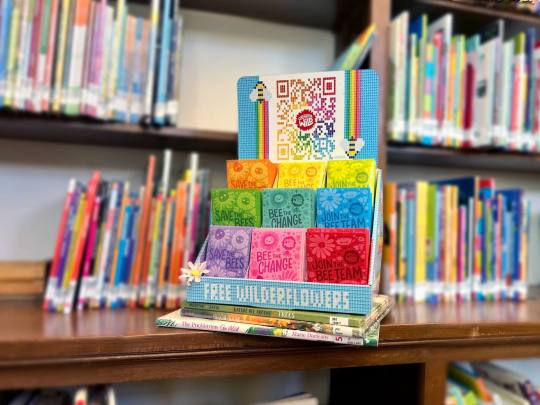
Named after Generation Wild’s official mascot “Wilder,” the Wilderflower Seed Mix was developed in partnership with Applewood Seed Co. and packets are now available for pickup at designated partner sites including more than 80 Little Free Library boxes.
By distributing 100,000 Wilderflower packets, Generation Wild is providing more than 56 million seeds for planting in every nook and cranny of the state. All seeds are regionally-native to Colorado, which is important for sustaining the living landscape of bees, birds, and other animals.
Additionally, by using flower species adapted to the Mile High climate, landscapers and gardeners need to use less water than if they were tending non-native plants.
“Applewood Seed Co. was excited to jump in and help Generation Wild identify a seed mix that is native to the Colorado region and the American West, containing a diversity of flower species to attract and support Colorado’s pollinator populations,” stated Norm Poppe, CEO of Applewood Seed Co. “We hope efforts like this continue to educate the public on pollinator conservation and the need to protect our native bees and butterflies.”
Concluding her statement Miller firmly stated that children grow up better outside, and if you or a parent you know agree with her, all the information on how to participate in Save the Bees! can be found here on their website, including a map showing all the local pickup points for the Wilderflower Seed Packets."
-via Good News Network, June 13, 2024
#wildflowers#wild flowers#colorado#bees#native bees#entomology#insects#save the bees#pollinators#bumblebees#bumble bee#i love bees#biodiversity#native plants#urban gardening#gardening#ecology#conservation#endangered species#wildlife conservation#enviromentalism#good news#hope#hope posting#solarpunk#denver#boulder colorado#colorado springs#libraries#public libraries
485 notes
·
View notes
Text

Plant a Bee-friendly (and butterfly friendly) garden!
See higher quality image and find out more:
PollinatorGardenBrochure.pdf (sierraclub.org)
#gardening#gardens#plants#pollinators#wildlifer#home#home and garden#conservation#environment#nature#animals#bees#butterflies#insects
485 notes
·
View notes
Text
If you're in the U.S. and want to support local plants and pollinators, I hope you've heard of the Xerces Society. Weird name, but super cool resource for gardening for insect pollinators (and they work for other invertebrate species, too)
They've got regional native plant lists:
They've also got super helpful things in their resources section, including Washington's plan for helping bumble bees:
Another really cool resource is the National Wildlife Federation's list of key stone plant species by ecoregion:
3K notes
·
View notes
Text
there is a special place in hell for cat owners who allow their cats to free-roam a residential neighborhood because it's ~natural~.
The amount of devastation and heartbreak I have seen from loved ones whose cats accidentally got out makes me like twice as mad too because I cannot. I cannot fathom the cruelty and selfishness required to ignore what we know to be best practice for cat husbandry because your feefees get uncomfies when people tell you it's animal abuse to wilfully, knowingly cut your cat's expected lifespan from 15-20 years to 2-3.
KEEP. YOUR. FUCKING. CATS. INSIDE.
#this does not apply to people who are doing their best to care for feral colonies while providing TNR and other essential healthcare#it also does not apply to people who are trying to keep their cats indoors#it's the people who have four or five outdoor cats and an ostentatious tesla and a ~wild pollinator~ sign in their garden#guess what sweetie fluffy does more damage to wild pollinators than twenty grass lawns#the performative environmentalism paired with blasé attitudes towards the welfare of animals in their care makes me fucking seethe
326 notes
·
View notes
Text
Dandelion News - November 15-21
Like these weekly compilations? Tip me at $kaybarr1735 or check out my Dandelion Doodles! (sorry it's slightly late, the links didn't wanna work and I couldn't figure it out all day)
1. Wyoming's abortion ban has been overturned, including its ban on abortion medication

“Wyoming is the second state to have its near-total abortion ban overturned this month[…. Seven other states] also approved amendments protecting the right to an abortion. A lawsuit seeking to challenge the [FDA]’s approval of abortion medication recently failed when the Supreme Court refused to hear it[….]”
2. Patches of wildflowers in cities can be just as good for insects as natural meadows – study

“This study confirmed that small areas of urban wildflowers have a high concentration of pollinating insects, and are as valuable to many pollinators as larger areas of natural meadow that you would typically find rurally.”
3. Paris could offer new parents anti-pollution baby 'gift bags' to combat 'forever chemicals'

“The bag includes a stainless steel baby cup, a wooden toy, reusable cotton wipes, and non-toxic cleaning supplies as part of a "green prescription". […] The city will also have 44 centres for protecting mothers and infants that will be without any pollutants[….]”
4. Indigenous guardians embark on a sacred pact to protect the lowland tapir in Colombia
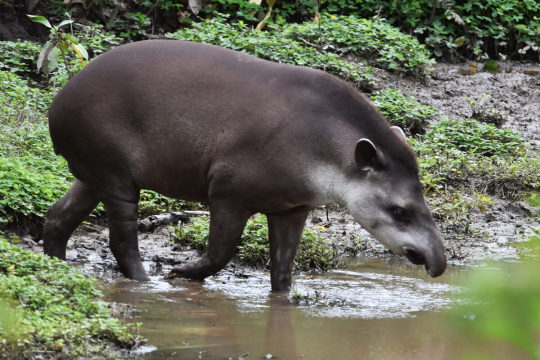
“The tapir is now the focus of an Indigenous-led conservation project[… A proposed “biocultural corridor”] will protect not only the populations and movements of wildlife such as tapirs, but also the cultural traditions and spirituality of the Inga and other neighboring Indigenous peoples[….]”
5. Denmark will plant 1 billion trees and convert 10% of farmland into forest

“[…] 43 billion kroner ($6.1 billion) have been earmarked to acquire land from farmers over the next two decades[.… In addition,] livestock farmers will be taxed for the greenhouse gases emitted by their cows, sheep and pigs from 2030, the first country to do so[….]”
6. The biggest grid storage project using old batteries is online in Texas

“[Element operates “used EV battery packs” with software that can] fine-tune commands at the cell level, instead of treating all the batteries as a monolithic whole. This enables the system to get more use out of each cell without stressing any so much that they break down[….]””
7. Durable supramolecular plastic is fully ocean-degradable and doesn't generate microplastics

“The new material is as strong as conventional plastics and biodegradable, [… and] is therefore expected to help reduce harmful microplastic pollution that accumulates in oceans and soil and eventually enters the food chain.”
8. Big Oil Tax Could Boost Global Loss and Damage Fund by 2000%

“[… A] tax on fossil fuel extraction, which would increase each year, combined with additional taxes on excess profits would […] generate hundreds of billions of dollars by the end of the decade to assist poor and vulnerable communities with the impact of the climate crisis[….]”
9. Rooftop solar meets 107.5 pct of South Australia’s demand, no emergency measures needed

“[T]he state was able to export around 658 MW of capacity to Victoria at the time[….] The export capacity is expected to increase significantly as the new transmission link to NSW[…] should be able to allow an extra 150 MW to be transferred in either direction by Christmas.”
10. Light-altering paint for greenhouses could help lengthen the fruit growing season in less sunny countries

“[Scientists] have developed a spray coating for greenhouses that could help UK farmers to produce more crops in the future using the same or less energy[… by optimising] the wavelength of light shining onto the plants, improving their growth and yield.”
November 8-14 news here | (all credit for images and written material can be found at the source linked; I don’t claim credit for anything but curating.)
#hopepunk#good news#abortion#abortion rights#reproductive rights#pollinators#guerrilla gardening#wildflowers#paris#babies#new parents#tapir#indigenous#denmark#reforestation#electric vehicles#energy storage#plastic#microplastics#biodegradable#fossil fuels#solar panels#gardening#solar energy#solar power#nature#us politics#technology#australia#uk
139 notes
·
View notes
Text
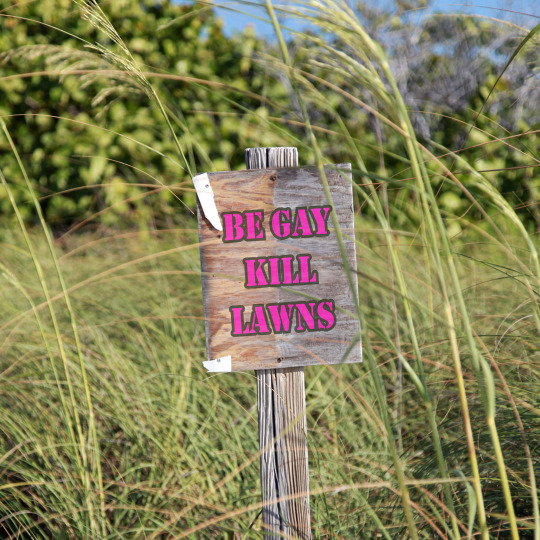
Be a good crime-doer. Gorilla garden the shit out of your neighbourhood.
#plants#botany#gardening#queer community#environment#garden#lgbt artist#nonbinary artist#lgbtq community#lgbtq#lgbtqia#lgbt pride#queer#queer pride#native plants#native garden#pollinator garden#pollinator gardening
2 notes
·
View notes
Text






Мордовник шароголовый (лат. Echinops sphaerocephalus) и привлеченные сладким ароматом пчелы. Август 24. Echinops sphaerocephalus and bees attracted by the sweet aroma. August 24.
#русский tumblr#россия#лето#природа#природный сад#травянистое растение#шмель#Мордовник шароголовый#опыление#пчела#мои фото#russia#summer#nature#nature photography#pollination#nature garden#herbaceous plant#Echinops sphaerocephalus#bee#bumblebee#beauty of nature#my photos#original photography#photographers on tumblr
253 notes
·
View notes
Text
Just had a vision of Gonta making an entire huge pollinator friendly garden with water features that he expands on constantly and he ropes his classmates in on helping him after the game (mainly because my mom is doing that with her garden and it's awesome)

#danganronpa#keys talks#gonta gardening my beloved#and he would know because he would need to to take care of bugs#gonta getting excited when he sees butterfly bushes#gonta infodumping about pollinators favorite plants and the ecosystem#ily gonta gokuhara#v3#drv3#ndrv3#danganronpa killing harmony#gonta gokuhara#ndrv3 post game au
259 notes
·
View notes